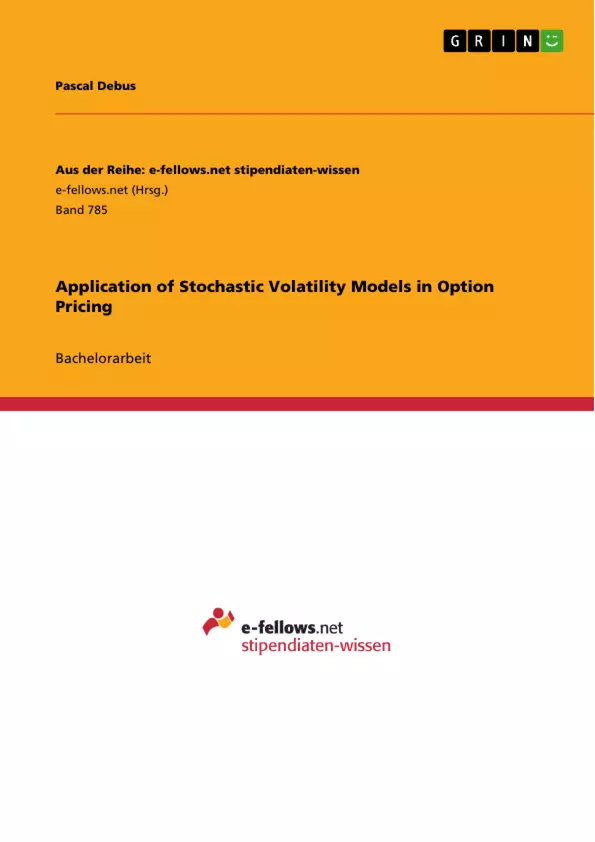The Black-Scholes (or Black-Scholes-Merton) Model has become the standard model for the pricing of options and can surely be seen as one of the main reasons for the growth of the derivative market after the model´s introduction in 1973. As a consequence, the inventors of the model, Robert Merton, Myron Scholes, and without doubt also Fischer Black, if he had not died in 1995, were awarded the Nobel prize for economics in 1997.
The model, however, makes some strict assumptions that must hold true for accurate pricing of an option. The most important one is constant volatility, whereas empirical evidence shows that volatility is heteroscedastic. This leads to increased mispricing of options especially in the case of out of the money options as well as to a phenomenon known as volatility smile. As a consequence, researchers introduced various approaches to expand the model by allowing the volatility to be non-constant and to follow a sto-chastic process. It is the objective of this thesis to investigate if the pricing accuracy of the Black-Scholes model can be significantly improved by applying a stochastic volatility model.
Inhaltsverzeichnis
- 1 Einleitung
- 1.1 Hintergrund
- 1.2 Problemstellung und Zielsetzung
- 1.3 Verlauf der Untersuchung
- 2 Optionsgrundlagen
- 2.1 Klassifikation und Arten von Optionen
- 2.2 Terminologie & Auszahlungscharakteristika
- 2.3 Put-Call-Parität
- 3 Stochastische Prozesse
- 3.1 Markov-Eigenschaft
- 3.2 Wiener-Prozess und Brownsche Bewegung
- 3.3 Itô-Prozess und Itô-Formel
- 3.4 Anwendung der Itô-Lemma auf Aktienkursbewegungen
- 4 Das Black-Scholes-Modell
- 4.1 Annahmen
- 4.2 Risikofreie Bewertung
- 4.3 Black-Scholes-Partielle Differentialgleichung
- 4.4 Black-Scholes-Preisformel
- 4.5 Bewertung von Modellparametern und Annahmen
- 4.6 Volatilitätsschmunzeln
- 5 Stochastische Volatilitätsmodelle
- 5.1 Überblick über stochastische Volatilitätsmodelle
- 5.2 Das Heston-Modell
- 5.2.1 Der mittlere-revertierende Quadratwurzel-Diffusionsprozess
- 5.2.2 Herleitung der Heston-PDE
- 5.3 Heston-Preisformel für europäische Calls
- 6 Empirische Analyse
- 6.1 Methodik
- 6.1.1 Geschlossene Formelnäherungen
- 6.1.2 Implementierung
- 6.2 Kalibrierung
- 6.2.1 Modellparameter
- 6.2.2 Kalibrierungsmethoden
- 6.3 Daten
- 6.4 Ergebnisse
- 6.4.1 Kalibrierungsergebnisse
- 6.4.2 Preisfindungsergebnisse
- 7 Modellauswertung
- 7.1 Interpretation der Ergebnisse
- 7.2 Nachteile des Modells
- 7.3 Ansätze für weitere Verbesserungen
- 7.3.1 Zeitabhängiges Heston-Modell
- 7.3.2 Sprung-Diffusions-Modell
Zielsetzung und Themenschwerpunkte
Die vorliegende Arbeit befasst sich mit der Anwendung stochastischer Volatilitätsmodelle in der Optionspreisfindung. Ziel ist es, die gängigen Modelle und Methoden zur Bewertung von Optionen mit stochastischer Volatilität zu analysieren und ihre Anwendung in der Praxis zu untersuchen.
- Einführung in die Optionspreisfindung und die zugrundeliegenden Konzepte
- Analyse von stochastischen Volatilitätsmodellen, insbesondere des Heston-Modells
- Empirische Validierung der Modelle anhand von realen Marktdaten
- Bewertung der Ergebnisse und Diskussion der Stärken und Schwächen der Modelle
- Exploration von Ansätzen zur Verbesserung der Modelle
Zusammenfassung der Kapitel
- Kapitel 1: Einleitung - Dieses Kapitel liefert einen einleitenden Überblick über die Arbeit, den Hintergrund der Optionspreisfindung und die Problemstellung, die durch stochastische Volatilität aufgeworfen wird. Die Zielsetzung und der Verlauf der Untersuchung werden vorgestellt.
- Kapitel 2: Optionsgrundlagen - Hier werden die grundlegenden Konzepte der Optionspreisfindung erläutert, darunter die Klassifikation und Arten von Optionen, Terminologie und Auszahlungscharakteristika sowie die Put-Call-Parität.
- Kapitel 3: Stochastische Prozesse - In diesem Kapitel werden wichtige stochastische Prozesse vorgestellt, die in der Optionspreisfindung verwendet werden, darunter der Wiener-Prozess, die Brownsche Bewegung und der Itô-Prozess. Die Anwendung der Itô-Lemma auf Aktienkursbewegungen wird ebenfalls behandelt.
- Kapitel 4: Das Black-Scholes-Modell - Das Black-Scholes-Modell, ein fundamentales Modell in der Optionspreisfindung, wird detailliert betrachtet. Annahmen, risikofreie Bewertung, die partielle Differentialgleichung und die Preisformel werden vorgestellt. Die Bewertung von Modellparametern und Annahmen sowie das Volatilitätsschmunzeln werden ebenfalls diskutiert.
- Kapitel 5: Stochastische Volatilitätsmodelle - Dieses Kapitel bietet einen Überblick über stochastische Volatilitätsmodelle und konzentriert sich auf das Heston-Modell. Der mittlere-revertierende Quadratwurzel-Diffusionsprozess und die Herleitung der Heston-PDE werden dargestellt.
- Kapitel 6: Empirische Analyse - Dieses Kapitel befasst sich mit der empirischen Analyse des Heston-Modells. Es werden die Methodik, die Implementierung, die Kalibrierung und die Ergebnisse der Anwendung des Modells auf reale Marktdaten vorgestellt.
Schlüsselwörter
Optionspreisfindung, stochastische Volatilität, Heston-Modell, Black-Scholes-Modell, empirische Analyse, Kalibrierung, Bewertung, Finanzmärkte, Derivate.
- Citation du texte
- Pascal Debus (Auteur), 2010, Application of Stochastic Volatility Models in Option Pricing, Munich, GRIN Verlag, https://www.grin.com/document/232541



